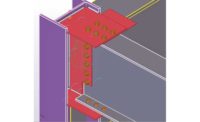A cloud-based digital engineer is hovering nearby, ready to calculate, design and optimize thousands of bolted and welded connections on 3D Tekla models as a service to subscribers.
QuickQnect is a Tekla plug-in about seven years in development and out in stealth mode since April. The developer says QuickQnect differs from other steel-connection software in that it uses powerful, in-the-cloud computers to examine loads rapidly, designing each connection to be as efficient as possible, rather than applying standard designs by connection type from a library.
To set up the tool, the engineer selects among dozens of preferences for job requirements, connection types, detailing, bolts and welds. Then, the model—or only parts of it—is uploaded to a cloud processor by clicking a button on the Tekla interface. The system extracts the forces and engineers the connections, says Jef Sharp, the developer and CEO of Qnect, Hadley, Mass.
Shawn Todd, detailing manager at W&W-AFCO Steel, Oklahoma City, tested an early release on a time-constrained overhaul of a University of Oklahoma football stadium. The challenge was to minimize design time once the project was approved in order to complete demolition and construction between football seasons. W&W used the tool only on gravity connections because slope- and moment-connection designs were not yet available. Sharp says slope connections now are included, and moment connections are coming in the next release, this April.
“The main reason we used it was to cut the amount of time,” Todd says. “We were successful, and we are very intrigued. I see value there.”
Qnect charges $10 per connection for the first run and no added fees if the same connections are re-run to tweak the preferences. “If you do revisions, you never have to pay again,” says Sharp. “In our world, you only pay that first time.”
“There is no setup charge and no maintenance charge,” adds Sharp. “A user just needs to have Tekla, go to our website and sign up. Then, download the app—
30 seconds—create a job and fill in the job preferences. Press button No. 1 to upload and button No. 2 to run again for optimization analysis.”
“I do think their product is special,” says Erleen Hatfield, a principal at BuroHappold Engineering, New York City. “I think [Sharp] is on to something, and what [Qnect is] doing could be a game-changer.”
Hatfield predicts the tool will be used more on the East Coast than the West Coast, where engineers hand-design connections to comply with seismic codes. But the traditional workflow of engineers handing off charts and tables to detailers is starting to change, claims Sharp, with engineers beginning to deliver connected models instead. He says the software can automate and optimize most connection design.
“The thing holding it up is, [the software developers] are not done yet,” Hatfield adds. “It doesn’t do the more complex connections, but we’re looking to use it at BoroHappold. We can accept that only 70% of it is done. It’s still providing a lot of value.”
Returning the model, the software attaches the engineering calculations and each connection’s fabrication cost as annotations in the 3D view and collected into reports. When the model has a deficiency or the software cannot do a connection type, Qnect flags a “no connection.”
“If we can’t connect it perfectly, it will issue a no-connection report and an explanation of why it wouldn’t connect,” says Sharp. The service also generates a report on the total cost of all the connections in a structure and tracks changes in cost and quantities each time the model is re-run.
The vendor gives an example of a 3,700-ton project in which 4,333 joints were connected in the model in 177 minutes. “At the end of that three hours, everything was accurate and ready for PE stamping to satisfy the loads given by the engineer,” Sharp says.
Preferences can be changed to see how the cost will be affected by, for example, lighter or heavier shear plates, welded single or double angles, and larger or smaller bolts. And models also can be run using a bolt optimizer to search for the most economical spacing and patterns at each connection.
Sharp claims CNC machines have no trouble deviating from traditional 3-in.-on-center bolt spacing, so spacing is not constrained to such patterns. He says that, compared to a traditionally connected design, the bolt optimizer can reduce the total bolt count by as much as 40%. “On some jobs, it’s amazing how many bolts you can save,” says Sharp. With the cost of bolts, drilling and assembly approaching $20 for each bolt, savings add up rapidly, he says.
“The idea that you can run something one way and then check a couple of boxes and run it another way is fabulous,” says Hatfield. “I can run all my connection designs with ¾-in. bolts, then run it again with 1-in. bolts, and the speed is wonderful. I’ve been running it on tests, but we are looking at trying it on a couple of projects.”
“Our schedule was so tight,” laments Todd. “I wish we would have had more time to optimize. We could have run four, five or six optimizations on the front end.” He says W&W is working to implement the software for estimating and, later, for detailing. “We are very interested in the bolt optimization tool and look forward to seeing how it can save money,” Todd says.





Post a comment to this article
Report Abusive Comment